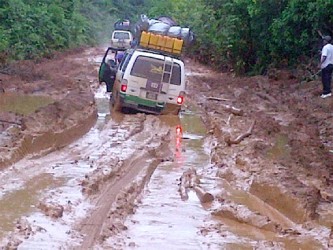As the poor state of the roads in interior locations continue to trigger protests, residents and business persons are losing patience over the potholes and mini trenches along the Mabura to Lethem road, which is being described as a “dangerous and treacherous” stretch.
Reports are that the road benefitted from major works in 2010 but had no further upgrade after this and it remains in an almost impassable state.
Calls made to the Minister of Public Works, Robeson Been for comment on the situation went unanswered. In recent weeks, residents of Bartica in Region Seven and Mahdia in Region Eight have mounted protests over neglect of their roads by central government.

Alliance For Change Member of Parliament Trevor Williams, speaking as an entrepreneur who plies the route, told Stabroek News that a special effort is needed by the government to address the issue that has been ongoing for years. “Anyone who tends to use the road has to incur the high cost of repairs and maintenance to their vehicles, endure longer periods of travel, risk their lives to cross bridges, get stuck into potholes that are no longer potholes but mini trenches which becomes exacerbated by the rain,” he said.
He called the attempts by government to fix the road “ineffective patchwork,” saying there has been no progressive remedy. According to him, they are grading the road when they should be compacting it with laterite, and they are also using sand and loam, which washes away soon after heavy rainfall.
Williams pointed out that big trucks with heavy cargo and log trucks also put too much strain on the road—an issue that he thinks needs to be addressed comprehensively and even regulated. He also lamented that there are protests at numerous places, like Linden-Kwakwani, 72 Miles, and Mahdia, where persons are affected by inferior and deplorable roads. This situation, he said, is totally unacceptable and warrants an entirely different approach. He added that a wholesome project, which involves more persons, could boost employment and have a longer lasting effect than the work being done now.
“I would suggest that the government consult with the Neighbourhood Democratic Council, Regional Democratic Council and residents to effectively maintain the road,” he said.
Summing up the effects of the poor conditions of the roads, he said, “It is bad for business; a danger to life and limb; increases the cost of living and further reduces commerce by increasing the cost of transport in terms of time and repairs and maintenance.” He added that the gold miners are also feeling the squeeze of the terrible roads and that all these things result in pressure on the common man.

Stabroek News also spoke with Regional Democratic Councilor Carl Parker, who said that the government fixes the road without consultation and does a poor job at it. The first shower that comes after a patchwork causes severe deterioration of the road, according to him.
Parker explained that the materials used by the contractors to rebuild the roads are simply not suitable for the terrain. He said the sand and loam are incompatible given the weather conditions and that laterite, if used properly, would be a more pertinent fit. “The roads are built to accommodate Bedford trucks but those larger, double axel with the additional weight of their cargo puts much unaccommodated for pressure on the roads and add to the breakdown,” he said.
The roads have to be built to accommodate these increased weights and frequency, Parker stressed. He said, “The government needs to review their strategy to upgrade the road to the level required to accommodate bigger vehicles, increase in traffic and economic activity in an effort to stimulate even more economic activity.”
He continued, “They need to consult the council and the residents to find alternative ways to address the problems, simply because their previous attempts have failed and local knowledge is sometimes better than engineering knowledge.”
According to Parker, some simple things could be done to make the road works more effective. He suggested that the roads need to be opened up, explaining that this means clearing the forest cover that prevents rapid evaporation of rain water and allows for further deterioration by keeping the road in a soft, mushy state. This, he says, is evident because the open sections of the road are much less deteriorated than the enclosed sections. A frequent user of the road, Terrence Crawford, who transports goods into the interior, told this newspaper that the whole situation is ugly. He lamented that it is a hazard to travel through the path to Lethem, especially at night.
The journey becomes lengthened by several hours, he related, indicating that the time taken varies on the type of vehicle used on the trip. He explained that when the roads were in better shape, it took between 14 to 18 hours per trip but because of its current state it takes over 24 hours to complete the journey.
Crawford shared his most recent experience of a truck being stuck in the road and blocking vehicular traffic. Persons were forced onto the side of the road and into the bush, which he said was very risky.
He added that the constant road issues cause the delays and further puts persons at risk of being robbed, killed or stranded. He is calling on the government to fulfill its obligation and provide better infrastructure for the people.








